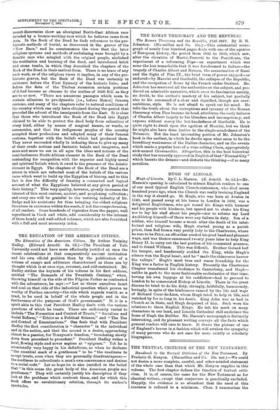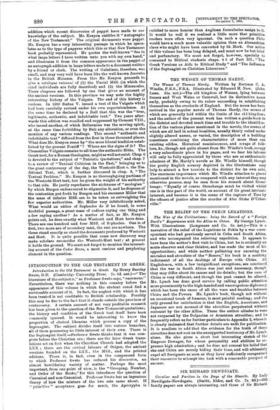THE TEXTUAL CRITICISM OF THE NEW TESTAMENT.
Handbook to the Textual Criticism of the New Testament. By Frederic G. Kenyon. (Macmillan and Co. 10s. net.)—We could not desire a more complete, careful, and sober-minded statement of the whole case than that which Mr. Kenyon supplies in this volume. The first chapter defines the function of textual criti- cism. It is, of course, the same for the New Testament as for classical writers, except that conjecture is practically excluded. Happily, the evidence is so abundant that the need of this resource is reduced to a minimum. Chan. 2 summarises the addition which recent discoveries of papyri have made to our knowledge of the subject. Mr. Kenyon entitles it "Autographs of the New Testament." The original documents were papyri. Mr. Kenyon has a very interesting passage in which he specu- lates as to the type of papyrus which this or that New Testament book probably represented. He quotes the well-known "See in what large letters I have written unto you with my own hand," and illustrates it from the common appearance in the papyri of an autograph addition in large letters made to a document written by a friend or clerk. The writing of Galatians, therefore, was small, and may very well have been like the well-known Isoerates in the British Museum. From this Mr. Kenyon proceeds to give a catalogue raisonnei of (1) the Uncial MSS. (in which the chief individuals are fully described) and (2) the Minuscules. These chapters are followed by one that gives an account of the ancient versions. In this province we may note the highly interesting history of the Vulgate. The end of this history is curious. In 1590 Sixtus V. issued a text of the Vulgate which had been carefully revised under his own superintendence. At the same time he declared by a Bull that this was the "true, legitimate, authentic, and indubitable text." Two years after- wards this edition was recalled and suppressed by Clement VIII., who issued another, of which Bellarmine was the moving spirit, at the same time forbidding by Bull any alteration, or even the mention of any various readings. This second "authentic and indubitable text" differed from the first in three thousand places. What does Mr. Kenyon mean by "the more liberal tradition estab- lished by the present Pontiff 'P Where are the signs of it ? The Clementine Vulgate remains to all time the authentic Bible. The Greek text, for a Roman theologian, might as well not exist. Chap. 6 is devoted to the subject of "Patristic Quotations," and chap. 7 to a review of "Textual Criticism in the Past," bringing us to the great controversy of the day, the Westcott-Hort v. the Tra- ditional Text, which is further discussed in chap. 8, "The Textual Problem." Mr. Kenyon is no thoroughgoing partisan of the Westcott-Hort text, but he gives the weight of his authority to that side. He justly repudiates the nickname of "neologian ", by which Burgon endeavoured to stigmatise it, and he disposes of the contention put forth by Burgon and his successor Miller that the mass of inferior MSS. are to be taken as outweighing the few superior authorities. Mr. Miller very infelicitously asked, What would an editor of Sophocles do if he found, in some doubtful passage, a great mass of codices saying one thing and a few saying another ? As a matter of fact, as Mr. Kenyon points out, he does exactly what Westcott and Hort have done. There are one hundred and four MSS. of Sophocles. One is of first, two more are of secondary rank, the rest are nowhere. The three stand exactly as stand the documents preferred by Westcott and Hort. It is quite possible that some new discovery may make scholars reconsider the Westcott-Hort text ;• at present it holds the ground. We must not forget to mention the interest- ing account of the Codex Bezae, a most curious and perplexing element in the question.































































 Previous page
Previous page